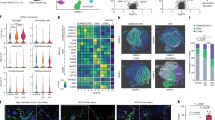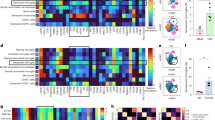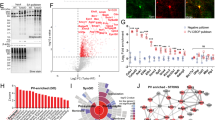Abstract
Missense mutations in the presenilin 1 (PS1) gene cause the most common form of dominant early–onset familial Alzheimer's disease (FAD)1,2 and are associated with increased levels of amyloid β–peptides (Aβ) ending at residue 42 (Aβ42) in plasma and skin fibroblast media of gene carriers3. Aβ42 aggregates readily and appears to provide a nidus for the subsequent aggregation of Aβ40 (ref. 4), resulting in the formation of innumerable neuritic plaques. To obtain in vivo information about how PS1 mutations cause AD pathology at such early ages, we characterized the neuropathological phenotype of four PS1–FAD patients from a large Colombian kindred5 bearing the codon 280 Glu to Ala substitution (Glu280Ala) PS1 mutation2. Using antibodies specific to the alternative carboxy–termini of Aβ, we detected massive deposition of Aβ42, the earliest and predominant form of plaque Aβ to occur in AD (ref. 6–8), in many brain regions. Computer–assisted quantification revealed a significant increase in Aβ42, but not Aβ40, burden in the brains from 4 PS1–FAD patients compared with those from 12 sporadic AD patients. Severe cerebellar pathology included numerous Aβ42–reactive plaques, many bearing dystrophic neurites and reactive glia. Our results in brain tissue are consistent with recent biochemical evidence of increased Aβ42 levels in PS1–FAD patients and strongly suggest that mutant PS1 proteins alter the proteolytic processing of the β–amyloid precursor protein at the C–terminus of Aβ to favor deposition of Aβ42
This is a preview of subscription content, access via your institution
Access options
Subscribe to this journal
Receive 12 print issues and online access
$209.00 per year
only $17.42 per issue
Buy this article
- Purchase on Springer Link
- Instant access to full article PDF
Prices may be subject to local taxes which are calculated during checkout
Similar content being viewed by others
References
Sherrington, R. et al. Cloning of a novel gene bearing missense mutations in early onset familial Alzheimer disease. Nature 375, 754–760 (1995).
Clark, R.F. et al. The structure of the presenilin 1 (S182) gene and identification of six novel mutations in early onset AD families. Nature Genet. 11, 219–222 (1995).
Scheuner, D. et al. Secreted amyloid β-protein similar to that in the senile plaques of Alzheimer's disease is increased in vivo by the presenilin 1 and 2 and APP mutations linked to familial Alzheimer's disease. Nature Med. 2, 864–870 (1996).
Jarrett, J.T. & Lansbury, P.T. Jr. Seeding “one-dimensional crystallization” of amyloid: A pathogenic mechanism in Alzheimer's disease and scrapie? Cell 73, 1055–1058 (1993).
Lopera, F. et al. Demencia tipo Alzheimer con agregación familiar en Antioquia, Colombia. Acta Neurol. Colombiana 10, 173–187 (1994).
Iwatsubo, T. et al. Visualization of A beta 42(43) and A beta 40 in senile plaques with end-specific A beta monoclonals: Evidence that an initially deposited species is A beta 42(43). Neuron 13, 45–53 (1994).
Iwatsubo, T., Mann, D.M., Odaka, A., Suzuki, N. & Ihara, Y. Amyloid β protein (Aβ) deposition: Aβ42(43) precedes Aβ40 in Down syndrome. Ann. Neurol. 37, 294–299 (1995).
Lemere, C.A. et al. Sequence of deposition of heterogeneous amyloid β-peptides and Apo E in Down syndrome: Implications for initial events in amyloid plaque formation. Neurobiol. Dis. 3, 16–32 (1996).
Yamaguchi, H., Sugihara, S., Ishiguro, K., Takashima, A. & Hirai, S. Immunohistochemical analysis of COOH-termini of amyloid beta protein (Aβ) using end-specific antisera for Aβ40 and Aβ42 in Alzheimer's disease and normal aging. Amyloid Int. J. Clin. Invest. 2, 7–16 (1995).
Saido, T.C. et al. Dominant and differential deposition of distinct β-amyloid peptide species, AβN3(p3), in senile plaques. Neuron. 14, 457–466 (1995).
Haltia, M. et al. Chromosome 14-encoded Alzheimer's disease: Genetic and clinicopathological description. Ann. Neurol. 36, 362–367 (1994).
Lampe, T.H. et al. Phenotype of chromosome 14-linked familial Alzheimer's disease in a large kindred. Ann. Neurol. 36, 368–378 (1994).
Kovacs, D.M. et al. Alzheimer-associated presenilins 1 and 2: Neuronal expression in brain and localization to intracellular membranes in mammalian cells. Nature Med. 2, 224–229 (1996).
Schmechel, D.E. et al. Increased amyloid β-peptide deposition in cerebral cortex as a consequence of apolipoprotein E genotype in late-onset Alzheimer disease. Proc. Natl. Acad. Sci. USA 90, 9649–9653 (1993).
Greenberg, S.M., Rebeck, G.W., Vonsattel, J.P.G., Gomez-Isla, T. & Hyman, B.T. Apolipoprotein E ɛ4 and cerebral hemorrhage associated with amyloid angiopathy. Ann. Neurol. 38, 254–259 (1995).
Song, X.-H. et al. Plasma amyloid β protein (Aβ) is increased in carriers of familial AD (FAD) linked to chromosome 14. Soc. Neurosd. Abstr. 21, 1501 (1995).
Jarrett, J.T., Berger, E.P. & Lansbury, P.T. Jr. The carboxy terminus of the beta amyloid protein is critical for the seeding of amyloid formation: Implications for the pathogenesis of Alzheimer's disease. Biochemistry 32, 4693–4697 (1993).
Tamaoka, A. et al. APP717 missense mutation affects the ratio of amyloid β protein species (Aβ1–42/43 and Aβ1–40) in familial Alzheimer's disease brain. J. Biol. Chem. 269, 32721–32724 (1994).
Mann, D.M.A. et al. Predominant deposition of amyloid-β42(43) in plaques in cases of Alzheimer's disease and hereditary cerebral hemorrhage associated with mutations in the amyloid precursor protein gene. Am. J. Pathol. 148, 1257–1266 (1996).
Suzuki, N. et al. An increased percentage of long amyloid β protein secreted by familial amyloid β protein precursor (βAPP717) mutants. Science 264, 1336–1340 (1994).
Citron, M. et al. Mutation of the β-amyloid precursor protein in familial Alzheimer's disease increases β-protein production. Nature 360, 672–674 (1992).
Cai, X.-D., Golde, T.E. & Younkin, G.S. Release of excess amyloid β protein from a mutant amyloid β protein precursor. Science 259, 514–516 (1993).
Citron, M. et al. Excessive production of amyloid β-protein by peripheral cells of symptomatic and presymptomatic patients carrying the Swedish familial Alzheimer's disease mutation. Proc. Natl. Acad. Sci. USA 91, 11993–11997 (1994).
Mann, D.M.A. et al. Amyloid β protein (Aβ) deposition in chromosome 14-linked Alzheimer's disease: Predominance of Aβ42(43). Ann. Neurol. 40, 149–156 (1996).
Kosik, K.S. et al. Epitopes that span the tau molecule are shared with paired helical filaments. Neuron 1, 817–825 (1988).
Author information
Authors and Affiliations
Rights and permissions
About this article
Cite this article
Lemere, C., Lopera, F., Kosik, K. et al. The E280A presenilin 1 Alzheimer mutation produces increased Aβ42 deposition and severe cerebellar pathology. Nat Med 2, 1146–1150 (1996). https://doi.org/10.1038/nm1096-1146
Received:
Accepted:
Issue Date:
DOI: https://doi.org/10.1038/nm1096-1146
This article is cited by
-
Involvement of the glymphatic/meningeal lymphatic system in Alzheimer’s disease: insights into proteostasis and future directions
Cellular and Molecular Life Sciences (2024)
-
Unraveling the Potential of EphA4: A Breakthrough Target and Beacon of Hope for Neurological Diseases
Cellular and Molecular Neurobiology (2023)
-
Effect of apolipoprotein genotype and educational attainment on cognitive function in autosomal dominant Alzheimer’s disease
Nature Communications (2023)
-
Quality of life in early-onset Alzheimer’s disease due to a PSEN1-E280A mutation
Neurological Sciences (2021)
-
Immortalised Hippocampal Astrocytes from 3xTG-AD Mice Fail to Support BBB Integrity In Vitro: Role of Extracellular Vesicles in Glial-Endothelial Communication
Cellular and Molecular Neurobiology (2021)



